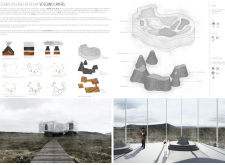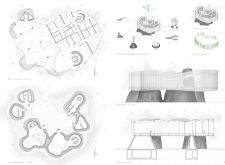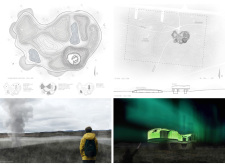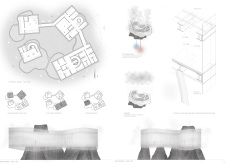5 key facts about this project
The design encapsulates three primary concepts: Magma, Rock, and Smoke, symbolizing various aspects of volcanic activity. This thematic approach not only informs the architectural style but also enhances the educational purpose of the museum, creating a space where visitors can engage with the narratives of Iceland's geological history. The project's exterior showcases a contemporary dialogue with the rugged landscape, employing a material palette that includes reinforced concrete, glass, steel framing, and local stone. These materials are carefully selected to invoke both the strength and the aesthetic qualities of the volcanic environment, ensuring the building resonates with its context.
Upon arrival, visitors encounter a layout that promotes exploration and discovery. An expansive foyer serves as the entry point, seamlessly connecting the indoors to the natural landscape. Large glass panels invite abundant natural light, while providing a visual connection to the striking surroundings. The architectural design utilizes an undulating roof that mirrors the nearby volcanic formations, integrating functional spaces such as exhibition halls, visitor amenities, and an observation area. This thoughtful arrangement facilitates a smooth flow through the museum, encouraging visitors to move freely from one area to the next.
Inside, the exhibition halls are designed to showcase a variety of volcanic artifacts, interactive displays, and educational exhibits. These spaces are generous in size, allowing for flexible arrangements that can accommodate changing exhibitions or events. The emphasis on natural light not only enhances the aesthetic experience but also bolsters the connection between the exhibits and the nature outside. Additionally, visitor amenities are crafted to ensure comfort, with spaces dedicated to relaxation, dining, and engagement with educational material.
An innovative aspect of the project is its commitment to sustainability. The museum incorporates a geothermal heating system, leveraging Iceland’s volcanic activity to minimize environmental impact. This design approach signifies a deep understanding of local resources, promoting an architectural practice that respects the natural environment. Furthermore, the landscape surrounding the museum is designed with native vegetation and water features that reflect the local topography, enriching the visitor experience while fostering biodiversity.
Unique design strategies are evident in the incorporation of viewing platforms and outdoor spaces that encourage interaction with the landscape. These carefully positioned viewpoints provide opportunities for contemplation and appreciation of the geological features that characterize Iceland. A roof garden enhances the environmental experience, allowing visitors to engage with the local ecosystem and understand the relationship between architecture and nature.
This project stands out not only for its educational mission but also for its thoughtful response to its geographical context. The architect's approach to designing the museum as a narrative structure, revealing the stories of volcanic activity through architecture, establishes a unique connection between visitors and the powerful forces that shape the landscape.
Readers interested in delving deeper into this impressive project are encouraged to explore its architectural plans, sections, designs, and innovative ideas. Each element contributes to a comprehensive understanding of how this museum embodies the cultural and geological significance of Iceland’s volcanic heritage, offering a valuable space for learning and exploration.


























